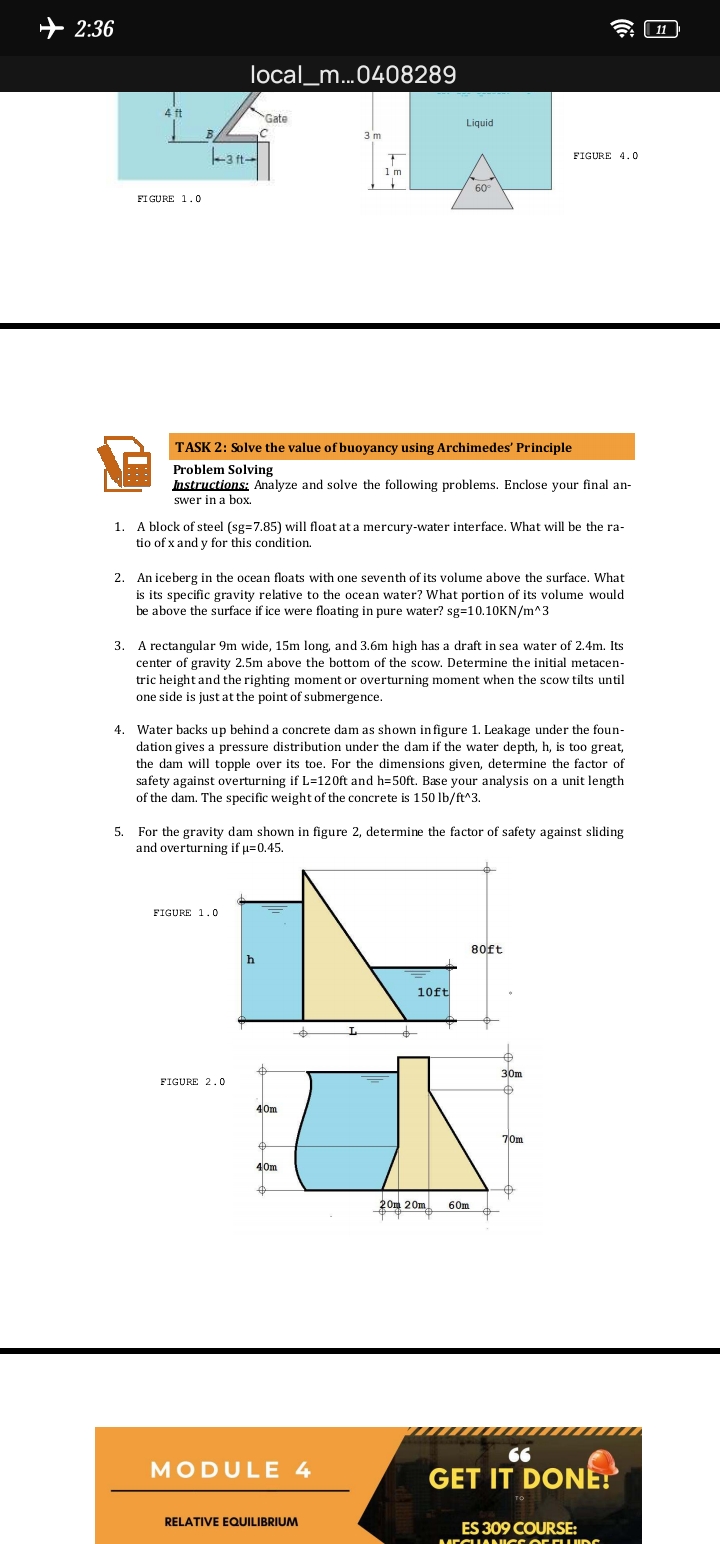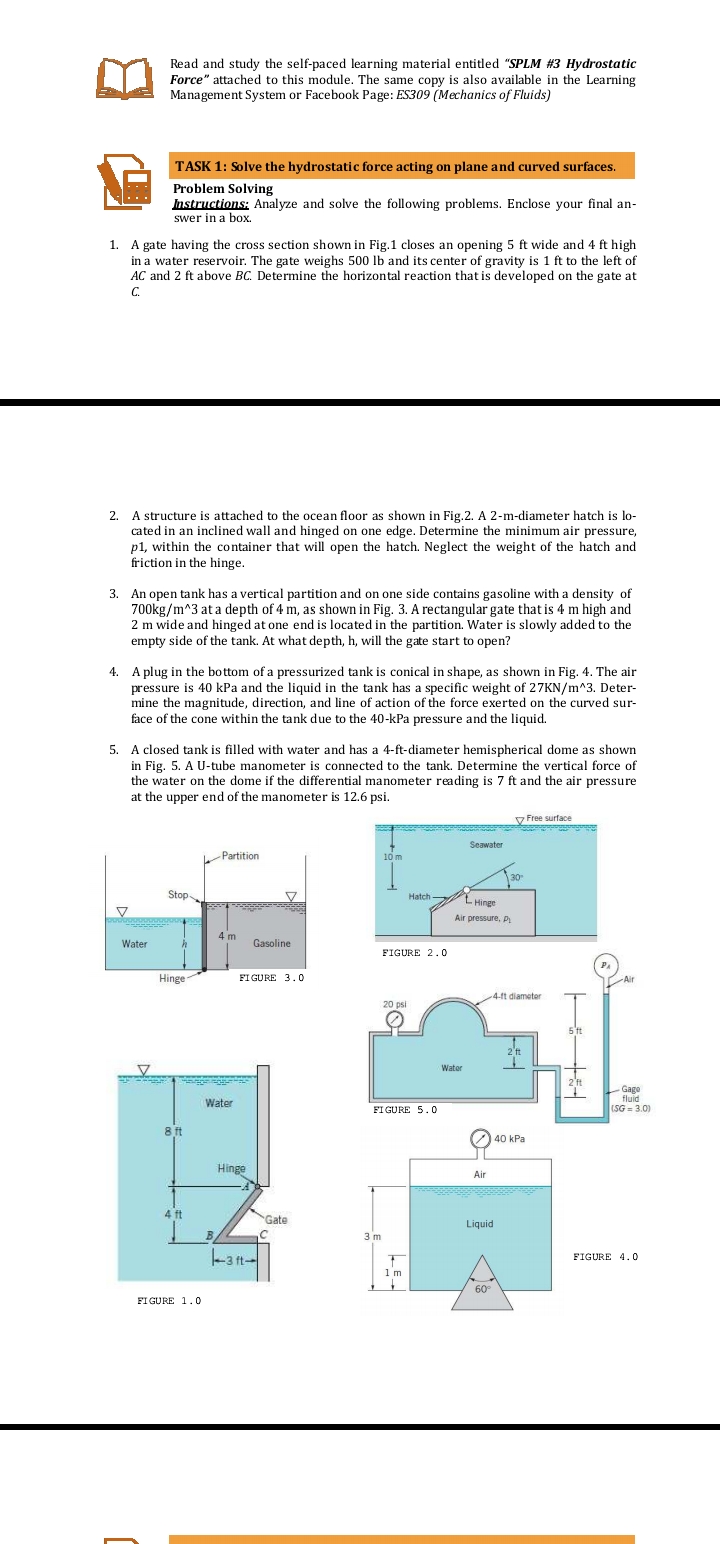1. A block of steel (sg=7.85) will float at a mercury-water interface. What will be the ra- tio of x and y for this condition.
1. A block of steel (sg=7.85) will float at a mercury-water interface. What will be the ra- tio of x and y for this condition.
Principles of Heat Transfer (Activate Learning with these NEW titles from Engineering!)
8th Edition
ISBN:9781305387102
Author:Kreith, Frank; Manglik, Raj M.
Publisher:Kreith, Frank; Manglik, Raj M.
Chapter5: Analysis Of Convection Heat Transfer
Section: Chapter Questions
Problem 5.5P: Evaluate the dimensionless groups hcD/k,UD/, and cp/k for water, n-butyl alcohol, mercury, hydrogen,...
Related questions
Question

Transcribed Image Text:2:36
| 11
local_m...0408289
Gate
Liquid
3 m
-3 ft-
FIGURE 4.0
1 m
60
FIGURE 1.0
TASK 2: Solve the value of buoyancy using Archimedes' Principle
Problem Solving
Instructions; Analyze and solve the following problems. Enclose your final an-
swer in a box.
1. A block of steel (sg=7.85) will float at a mercury-water interface. What will be the ra-
tio of x and y for this condition.
2. An iceberg in the ocean floats with one seventh of its volume above the surface. What
is its specific gravity relative to the ocean water? What portion of its volume would
be above the surface if ice were floating in pure water? sg=10.10KN/m^3
3. A rectangular 9m wide, 15m long, and 3.6m high has a draft in sea water of 2.4m. Its
center of gravity 2.5m above the bottom of the scow. Determine the initial metacen-
tric height and the righting moment or overturning moment when the scow tilts until
one side is just at the point of submergence.
4. Water backs up behind a concrete dam as shown infigure 1. Leakage under the foun-
dation gives a pressure distribution under the dam if the water depth, h, is too great,
the dam will topple over its toe. For the dimensions given, determine the factor of
safety against overturning if L=120ft and h=50ft. Base your analysis on a unit length
of the dam. The specific weight of the concrete is 150 lb/ft^3.
5. For the gravity dam shown in figure 2, determine the factor of safety against sliding
and overturning if µ=0.45.
FIGURE 1.0
80ft
h
10ft
30m
FIGURE 2.0
40m
70m
40m
20m 20m
60m
66
MODULE 4
GET IT DONE!
RELATIVE EQUILIBRIUM
ES 309 COURSE:
MEGIANICS C EFLIDG

Transcribed Image Text:Read and study the self-paced learning material entitled "SPLM #3 Hydrostatic
Force" attached to this module. The same copy is also available in the Learning
Management System or Facebook Page: ES309 (Mechanics of Fluids)
TASK 1: Solve the hydrostatic force acting on plane and curved surfaces.
Problem Solving
Instructions: Analyze and solve the following problems. Enclose your final an-
swer in a box.
1. A gate having the cross section shown in Fig.1 closes an opening 5 ft wide and 4 ft high
in a water reservoir. The gate weighs 500 lb and its center of gravity is 1 ft to the left of
AC and 2 ft above BC. Determine the horizontal reaction that is developed on the gate at
C.
2. A structure is attached to the ocean floor as shown in Fig.2. A 2-m-diameter hatch is lo-
cated in an inclined wall and hinged on one edge. Determine the minimum air pressure,
p1, within the container that will open the hatch. Neglect the weight of the hatch and
friction in the hinge.
3. An open tank has a vertical partition and on one side contains gasoline with a density of
700kg/m^3 at a depth of 4 m, as shown in Fig. 3. A rectangular gate that is 4 m high and
2 m wide and hinged at one end is located in the partition. Water is slowly added to the
empty side of the tank. At what depth, h, will the gate start to open?
4. A plug in the bottom of a pressurized tank is conical in shape, as shown in Fig. 4. The air
pressure is 40 kPa and the liquid in the tank has a specific weight of 27KN/m^3. Deter-
mine the magnitude, direction, and line of action of the force exerted on the curved sur-
face of the cone within the tank due to the 40-kPa pressure and the liquid.
5. A closed tank is filled with water and has a 4-ft-diameter hemispherical dome as shown
in Fig. 5. A U-tube manometer is connected to the tank. Determine the vertical force of
the water on the dome if the differential manometer reading is 7 ft and the air pressure
at the upper end of the manometer is 12.6 psi.
v Free surface
Seawater
Partition
10 m
30
Stop
Hatch L Hinge
V
Air pressure, P
4 m
Water
Gasoline
FIGURE 2.0
Hinge
FI GURE 3.0
Air
4-ft diameter
20 psi
5't
2'ft
Water
2'ft
Gage
fluid
Water
FI GURE 5.0
(SG = 3.0)
8 ft
40 kPa
Hinge
Air
4 ft
Gate
Liquid
3 m
-3 ft-
FIGURE 4.0
1 m
60
FIGURE 1.0
Expert Solution
This question has been solved!
Explore an expertly crafted, step-by-step solution for a thorough understanding of key concepts.
This is a popular solution!
Trending now
This is a popular solution!
Step by step
Solved in 4 steps with 2 images

Knowledge Booster
Learn more about
Need a deep-dive on the concept behind this application? Look no further. Learn more about this topic, mechanical-engineering and related others by exploring similar questions and additional content below.Recommended textbooks for you

Principles of Heat Transfer (Activate Learning wi…
Mechanical Engineering
ISBN:
9781305387102
Author:
Kreith, Frank; Manglik, Raj M.
Publisher:
Cengage Learning

Principles of Heat Transfer (Activate Learning wi…
Mechanical Engineering
ISBN:
9781305387102
Author:
Kreith, Frank; Manglik, Raj M.
Publisher:
Cengage Learning